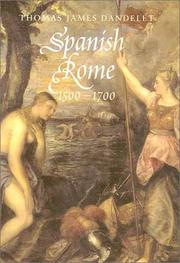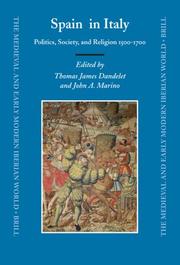| Listing 1 - 9 of 9 |
Sort by
|

ISBN: 0300089562 9780300089561 Year: 2001 Publisher: New Haven London Yale University Press
Abstract | Keywords | Export | Availability | Bookmark
 Loading...
Loading...Choose an application
- Reference Manager
- EndNote
- RefWorks (Direct export to RefWorks)
The story of the meeting of two great empires. Thomas James Dandelet explores the close relationship between the Spanish Empire and Papal Rome that developed in the dynamic period of the Italian Renaissance and the Spanish Golden Age.
History of Italy --- History of Spain --- anno 1600-1699 --- anno 1500-1599 --- Rome --- History. --- Italy --- Regions & Countries - Europe --- History & Archaeology --- Catholic Church --- Foreign relations --- Rome (Italy) --- Papal States --- Spain --- History --- Politics and government. --- Catholic Church. --- Espanja --- Spanien --- Hiszpania --- Spanish State --- España --- Estado Español --- Espagne --- Hispania --- Sefarad --- Sepharad --- Shpanye --- Shpanie --- Reino de España --- Kingdom of Spain --- Reino d'Espanya --- Reinu d'España --- Espainiako Erresuma --- Regne d'Espanya --- Reiaume d'Espanha --- Espanya --- Espanha --- スペイン --- Supein --- イスパニア --- Isupania --- 1420-1798 --- Politics and government --- Church of Rome --- Roman Catholic Church --- Katholische Kirche --- Katolyt︠s︡ʹka t︠s︡erkva --- Römisch-Katholische Kirche --- Römische Kirche --- Ecclesia Catholica --- Eglise catholique --- Eglise catholique-romaine --- Katolicheskai︠a︡ t︠s︡erkovʹ --- Chiesa cattolica --- Iglesia Católica --- Kościół Katolicki --- Katolicki Kościół --- Kościół Rzymskokatolicki --- Nihon Katorikku Kyōkai --- Katholikē Ekklēsia --- Gereja Katolik --- Kenesiyah ha-Ḳatolit --- Kanisa Katoliki --- כנסיה הקתולית --- כנסייה הקתולית --- 가톨릭교 --- 천주교
Book
ISBN: 1139897934 113990390X 1139045709 0521769930 0521747325 Year: 2014 Publisher: Cambridge : Cambridge University Press,
Abstract | Keywords | Export | Availability | Bookmark
 Loading...
Loading...Choose an application
- Reference Manager
- EndNote
- RefWorks (Direct export to RefWorks)
This book brings together a bold revision of the traditional view of the Renaissance with a new comparative synthesis of global empires in early modern Europe. It examines the rise of a virulent form of Renaissance scholarship, art, and architecture that had as its aim the revival of the cultural and political grandeur of the Roman Empire in Western Europe. Imperial humanism, a distinct form of humanism, emerged in the earliest stages of the Italian Renaissance as figures such as Petrarch, Guarino, and Biondo sought to revive and advance the example of the Caesars and their empire. Originating in the courts of Ferrara, Mantua, and Rome, this movement also revived ancient imperial iconography in painting and sculpture, as well as Vitruvian architecture. While the Italian princes never realized their dream of political power equal to the ancient emperors, the Imperial Renaissance they set in motion reached its full realization in the global empires of sixteenth- and seventeenth-century Spain, France, and Great Britain.
Imperialism --- Colonialism --- Empires --- Expansion (United States politics) --- Neocolonialism --- Political science --- Anti-imperialist movements --- Caesarism --- Chauvinism and jingoism --- Militarism --- Economic aspects --- Colonies --- History. --- Europe --- Council of Europe countries --- Eastern Hemisphere --- Eurasia --- Rome --- History --- Civilization --- Roman influences.
Book
ISBN: 1281722812 9786611722814 0300133774 Year: 2001 Publisher: New Haven : Yale University Press,
Abstract | Keywords | Export | Availability | Bookmark
 Loading...
Loading...Choose an application
- Reference Manager
- EndNote
- RefWorks (Direct export to RefWorks)
In the sixteenth and seventeenth centuries, Rome was an aged but still vigorous power while Spain was a rising giant on track toward becoming the world's most powerful and first truly global empire. This book tells the fascinating story of the meeting of these two great empires at a critical moment in European history. Thomas Dandelet explores for the first time the close relationship between the Spanish Empire and Papal Rome that developed in the dynamic period of the Italian Renaissance and the Spanish Golden Age. The author examines on the one hand the role the Spanish Empire played in shaping Roman politics, economics, culture, society, and religion and on the other the role the papacy played in Spanish imperial politics and the development of Spanish absolutism and monarchical power.Reconstructing the large Spanish community in Rome during this period, the book reveals the strategies used by the Spanish monarchs and their agents that successfully brought Rome and the papacy under their control. Spanish ambassadors, courtiers, and merchants in Rome carried out a subtle but effective conquest by means of a distinctive "informal" imperialism, which relied largely on patronage politics. As Spain's power grew, Rome enjoyed enormous gains as well, and the close relations they developed became a powerful influence on the political, social, economic, and religious life not only of the Iberian and Italian peninsulas but also of Catholic Reformation Europe as a whole.
Catholic Church --- Foreign relations --- Rome (Italy) --- Papal States --- Spain --- History --- Politics and government. --- Catholic Church.
Multi
ISBN: 9780521769938 9780521747325 9781139045704 Year: 2014 Publisher: New York Cambridge University Press
Abstract | Keywords | Export | Availability | Bookmark
 Loading...
Loading...Choose an application
- Reference Manager
- EndNote
- RefWorks (Direct export to RefWorks)
Renaissance --- History of Europe --- anno 1400-1499 --- anno 1300-1399 --- anno 1600-1699 --- anno 1500-1599 --- Imperialism --- Impérialisme. --- Europe --- Economic aspects --- Colonies --- History. --- Histoire. --- History --- Civilization --- Roman influences. --- Colonialism --- Empires --- Expansion (United States politics) --- Neocolonialism --- Political science --- Anti-imperialist movements --- Caesarism --- Chauvinism and jingoism --- Militarism --- Economic aspects&delete& --- Colonies&delete& --- Council of Europe countries --- Eastern Hemisphere --- Eurasia --- Rome --- Impérialisme --- Aspect économique --- Histoire --- Civilisation --- Influence latine --- Influence latine. --- Colonies européennes --- Impérialisme --- Colonies européennes --- Aspect économique

ISBN: 9004154299 9789004154292 9786611400798 1281400793 9047411188 9789047411185 9781281400796 6611400796 Year: 2007 Volume: 32 Publisher: Leiden ; Boston : Brill,
Abstract | Keywords | Export | Availability | Bookmark
 Loading...
Loading...Choose an application
- Reference Manager
- EndNote
- RefWorks (Direct export to RefWorks)
Nuanced understanding of the reciprocal nature of Spanish-Italian relations and the rich cultural production that was the product of the far-reaching exchanges between the two peninsulas throughout the early modern period guides the nineteen essays in this volume. The key political reality of sixteenth and seventeenth-century Spanish imperial domination in Italy—formal (Sicily, Sardinia, Naples, Milan), informal (Rome, Genoa, Tuscany), and more neutral or independent (Venice)—introduces the investigation in this volume into the methods and mechanisms of control and collaboration, cooperation and cooptation, assimilation and resistance. The connections between topics and problems in social, administrative, economic, and cultural history follow from political theory and practice. Politics, society, economy, and religion help us see both Spain and Italy more clearly.
Italy --- Spain --- History --- Social conditions --- Relations --- Civilization --- Spanish influences. --- Espanja --- Spanien --- Hiszpania --- Spanish State --- España --- Estado Español --- Espagne --- Hispania --- Sefarad --- Sepharad --- Shpanye --- Shpanie --- Reino de España --- Kingdom of Spain --- Reino d'Espanya --- Reinu d'España --- Espainiako Erresuma --- Regne d'Espanya --- Reiaume d'Espanha --- Espanya --- Espanha --- スペイン --- Supein --- イスパニア --- Isupania --- Repubblica italiana (1946- ) --- Italian Republic (1946- ) --- Włochy --- Regno d'Italia (1861-1946) --- Iṭalyah --- Italia --- Italie --- Italien --- Italii︠a︡ --- Kgl. Italienische Regierung --- Königliche Italienische Regierung --- إيطاليا --- Īṭāliyā --- جمهورية الإيطالية --- Jumhūrīyah al-Īṭālīyah --- Італія --- Італьянская Рэспубліка --- Italʹi︠a︡nskai︠a︡ Rėspublika --- Италия --- Италианска република --- Italianska republika --- Ιταλία --- Ιταλική Δημοκρατία --- Italikē Dēmokratia --- 이탈리아 --- It'allia --- 이탈리아 공화국 --- It'allia Konghwaguk --- איטליה --- רפובליקה האיטלקית --- Republiḳah ha-Iṭalḳit --- Lýðveldið Ítalía --- Itālija --- Itālijas Republika --- Italijos Respublika --- Olaszország --- Olasz Köztársaság --- イタリア --- Itaria --- イタリア共和国 --- Itaria Kyōwakoku --- Italiya Respublikasi --- Италия Республикаси --- Italii︠a︡ Respublikasi --- Итальянская Республика --- Італійська Республіка --- Italiĭsʹka Respublika --- İtalya --- İtalya Cumhuriyeti --- איטאליע --- Iṭalye --- 意大利 --- Yidali --- 意大利共和国 --- Yidali Gongheguo --- Laško --- Sardinia (Italy) --- Італійська Республіка
Book

ISBN: 9780857450500 Year: 2008 Publisher: New York Oxford
Abstract | Keywords | Export | Availability | Bookmark
 Loading...
Loading...Choose an application
- Reference Manager
- EndNote
- RefWorks (Direct export to RefWorks)
Multi

ISBN: 9780857450500 Year: 2008 Publisher: New York; ; Oxford Berghahn Books
Abstract | Keywords | Export | Availability | Bookmark
 Loading...
Loading...Choose an application
- Reference Manager
- EndNote
- RefWorks (Direct export to RefWorks)
Book

ISBN: 9781463231897 Year: 2010 Publisher: Piscataway, NJ
Abstract | Keywords | Export | Availability | Bookmark
 Loading...
Loading...Choose an application
- Reference Manager
- EndNote
- RefWorks (Direct export to RefWorks)
Multi

ISBN: 9781463231897 9781617199332 Year: 2010 Publisher: Piscataway, N.J. Gorgias Press
Abstract | Keywords | Export | Availability | Bookmark
 Loading...
Loading...Choose an application
- Reference Manager
- EndNote
- RefWorks (Direct export to RefWorks)
| Listing 1 - 9 of 9 |
Sort by
|

 Search
Search Feedback
Feedback About UniCat
About UniCat  Help
Help News
News